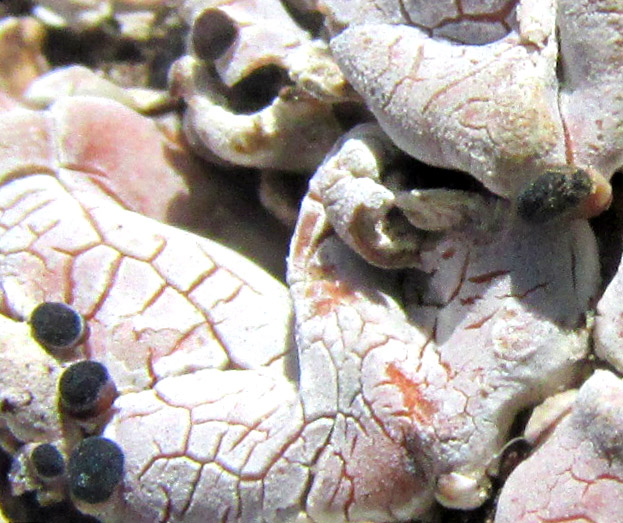Excerpts from Jim Conrad's
Naturalist Newsletter
Entry dated March 9, 2024, from notes taken about 2kms west of Higuerillas, Municipality of Cadereyta de Montes; N20.9086°, W99.7865°, elevation ~1760 meters (~5760 feet); on greywacke sandstone cap of hill; area constituting a narrow belt of the extreme southern extension of the Chihuahuan Desert, Meridional Subregion; central Querétaro state, MÉXICO
FISHSCALE LICHEN

The above shows more rock and moss-carpet than lichen. The small population of white, roundish lichens lies between my fingers at the picture's lower, right corner. So much rock is shown because when identifying rock- and soil-inhabiting lichens, often it's important to take into account the chemical nature of the lichen's substrate.
The rocks shown are part of a hill-capping geological unit known as the San Juan de La Rosa Formation. The 2014 Master's thesis of Leticia Millán Sánchez entitled "Caracterización Geométrica de la Deformación de la Formación San Juan de La Rosas (Jurásico), en el Área de Tolimán, Querétaro," lists one constituent of the San Juan de La Rosa Formation as evaporites composed of crystalline salts. Evaporites are layered crystalline sedimentary rocks formed from the ancient evaporation of salts-bearing water. The above rocks seem to be partly crystallized calcareous evaporites.

This lichen, instead of neatly fitting into the usual crustose, foliose or fruticose lichen categories, is said to be a squamulose lichen. The scattered, individual lichen bodies are referred to as squamules. Some think of squamulose lichens as intermediate forms between crustose and foliose lichens, while others regard them as special types of crustose lichens. While numerous soil-dwelling lichen species are of the squamulose type, this species' squamules are notable for often being depressed in their centers. Normally I don't try to identify squamulose lichens because so few features are visible to the naked eye, but some of these squamules bore spore-producing apothecia, better shown below:

In this species, as seen above in the bottom, left corner, apothecia arise at squamule margins. Unlike most apothecia, the spore-producing tops of these apothecia are not surrounded by obvious rims of the lichen's body tissue. Having no stalks, they're like black-headed warts. The body is covered with white, powdery granules, a condition described as having a pruinose surface. The lichen's pruinose surface is conspicuously and irregularly fissured, or cracked, revealing a pinkish body upper surface.
Despite these unusual features, I had a hard time identifying this lichen. One reason was because my Internet image search for white lichens on soil in Mexico turned up only two or three pictures similar to our lichen, and possibly those were misidentified. They were said to an endangered species occurring only in southern California and Baja California, Mobergia calculiformis. I contacted Frank Bungartz at Arizona State University, who helped the IUCN Red List organization designate the species as endangered, who I thought might be interested.
Frank replied "... the species that you found is called PSORA CRENATA and it is one of the most common soil lichens in the Sonoran Region." Further he described it was found all the way from lower desert to high mountain sites. It's one of two species with a pinkish body surface, the cortex, exposed by the cracks. Also, our lichen's apothecia are distinctive because of their black tops, which typically swell and push over the margins so that they are not seen -- "lecideine apothecia," as Frank called them.
Psora crenata usually is named Fishscale Lichen, though that name can be applied to all the 16 or so species currently accepted at the Species Fungorum database. Earlier we've seen another Fishscale, which was dark brown with white borders.
Psora species, found nearly worldwide, generally are thought of as producing relatively large, thick squamules. Our Psora crenata occurs in North America and Mexico, southern Africa and Australia. Contrasting with my first impressions, this lichen is widespread and apparently common wherever there's open soil in relatively dry zones, from deserts to juniper and pine forests.
Psora crenata often contributes greatly to biological soil crust, or "biocrust," which is a community of living organisms developed atop soil in arid and semi-arid ecosystems. Not only does biocrust retard soil erosion, but also its organisms provide a surprisingly large amount of both carbon fixation and nitrogen fixation. It affects germination of, and nutrient availability to other plants. Also it's very vulnerable to fire, offroading four-wheelers, livestock grazing and other disturbances.
The 1999 study by D.J. Eldridge and J.M. Ferris entitled "Recovery of Populations of the Soil Lichen Psora Crenata After Disturbance in Arid South Australia," suggests that after disturbances, "... at least 60 years is required for disturbed sites to approach the condition of undisturbed sites." Also the study confirmed that lichen recovery in such areas is very slow, and that our Psora crenata can be a useful indicator of recovery after rangeland disturbances.